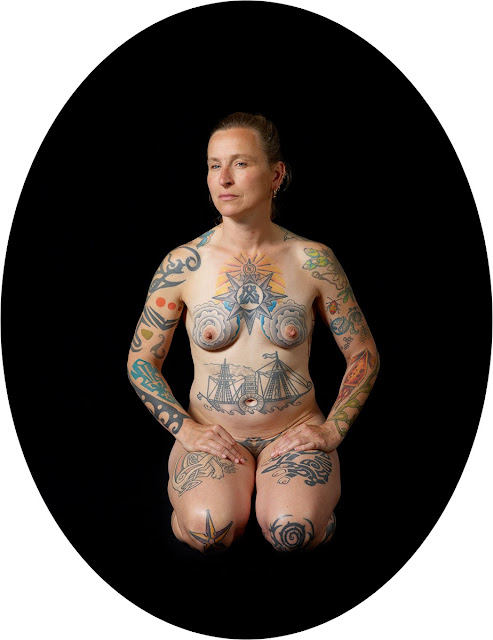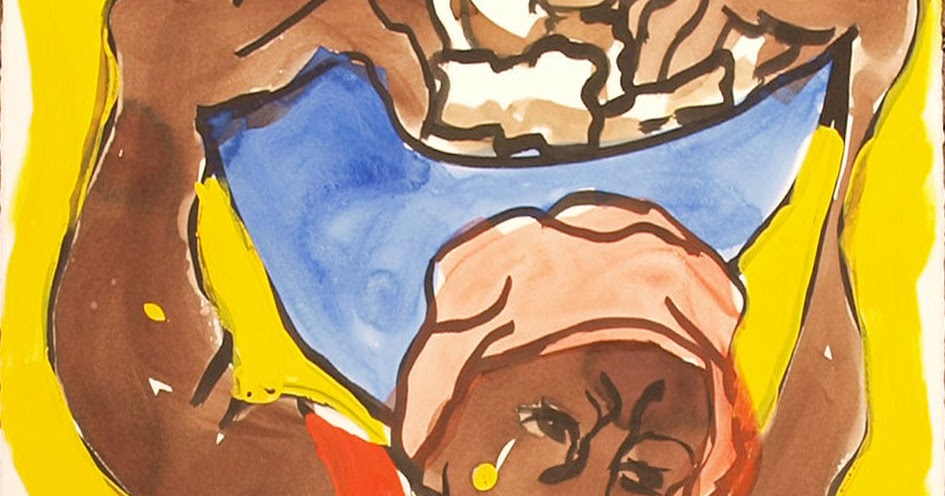Advertisements
I think Thomas Edison has already been installed to replace William Allen as an Ohio icon in the Statuary Hall of the Capitol. If I had known that ours was Catherine Opie's home state, I would have done something to see her enshrined instead. alongside James Garfield as a representative of Ohio's glory. Step aside, second-tier presidents, when we have artists of true stature and vision.
|
Certainly Opie's photographs in Portraits and Landscapes, showing at the Wexner Center in Columbus through August 2, would be right at home in the proudest traditional setting of marble and columns. If we were in the 17th-century galleries of a great European museum, our feelings would certainly be very similar to those we experience as we move at a considered pace through this exhibit.
Each of Opie's assistants appears before a deep, impenetrable black background. Whether we register this as a void or as an infinite depth, the effect is the same in both cases. It places the subject in a timeless three-dimensional space entirely their own, unrelated to any other place or time.
The effect is to carve the figure out of this medium of black. The light not only defines the subject's features, emphasizing one over the other, but frees the form from darkness as sculptures are said to free figures from large pieces of stone. Thus, through two portrait galleries, each figure is captured in a second birth, born not of the flesh but of the mind, effort and imagination. They are individuals born like Athena from the head of Zeus, fully grown and mature. ( An interesting comparison can be made in http://www.modigliani-drawings.com/nude%20in%20profile.htm .)
In her portrait, Miranda wears a dress of almost Quaker simplicity and understatement. Her claret color and red hair mediate between darkness and luminous skin and blue eyes that shine in her firm and resolute expression. Beauty can be a poisoned gift. Here, beauty is neither disguised nor avoided; its possessor can carry the weight with the chin slightly raised, directly returning the viewer's gaze. The image portrays the strength, stature and balance of an impeccably beautiful woman with nothing – not even her perfect face – to hide.
Miranda, a three-quarter portrait of a woman of noble bearing, is clearly related to a long tradition of Western portraits, evident in any museum one cares to visit. While this A certain woman captivates us with her seriousness and beauty, we also know that, individually, her photographer places her among a class of people who demand our utmost respect. The setting, the attention to detail, the lighting tell us this. Do we really need to know who she is? Here is an illustrious individual who is also a participant in the centuries-old tradition of women posing for posterity. She's a; she is other.
When we visit museum galleries filled with grand, moving portraits of Renaissance, Enlightenment, or 19th-century royalty, clergy, poets, and concubines, how often do we know who the people depicted were or what they accomplished in the world? Certainly not as often as we would like. King George? Henrique? And what number? No guesses! However, we interpret images through our understanding, general knowledge, and imaginations through art itself, through conventions and deviations from them; of our own reactions to images of luxury, eccentricity and beauty. We react to the story the artist told and create the central figure to satisfy our use of painting. A-historical? Anachronistic? Yes. Totally common? Yes again.
In fact, we do the same thing with contemporary portraits simply because we don't know everyone who is considered important to image makers. Nor should we. In this series of portraits, Opie identifies his subjects only by their first names. The way they were placed seems to have been largely down to the artist, who received lovely testimonials from many of her subjects for the generous or enlightening experiences they had with her. As reported in the gallery notes, artist Kara Walker noted that before many scheduled portrait sessions, she was not at her best: “There are a handful of images of well-known artists out there at my darkest, lowest points. Cathy’s manner and the resulting images show me feeling cool, in control, showing off my muscles… I felt a surge of ownership or at least companionship – that we would strive to correct this past.”
| Catarina Opie, Maria, 2013. Pigmented print, 50 x 38.4. ©Catherine Opie. Image courtesy of the artist and Regen Projects, Los Angeles |
So yes, Opie's subjects are eminent people, contemporary artists working at the forefront of visual arts, literature, performance and music. Even though many are recognized by a relatively small audience, they are constantly photographed. Miranda, above, is the filmmaker/performance artist/writer/actor Miranda July. If you haven't seen her before, just Google her image: there are pages of them. It's a worthwhile exercise to understand the difference between an image and a portrait.
These days, images are everywhere by accident and design. The tradition of great portraits in which Opie places this series derives from times when images of the great were rare and precious. A painted portrait of Voltaire would become the basis for engravings, which could be printed and disseminated at low cost. But the world was not saturated by an endless stream of unique images of a single eminent person who was redecorated and whose personality was reshaped daily. There was a constancy in the core identities of intellectuals and artists. These portraits, in this way, return to this idea of constancy.
Insofar as Opie's portraits help define and establish identities, she uses visual tradition as a framework upon which to organize the central ideas, works, and identities of the individuals depicted. The black background, the exquisitely controlled lighting, the dignity of the pose, the shapes of the portraits: they form the traditional tableau that ensures a place of honor. Within this framework, the individual is exactly as portrayed – naked or clothed; real or worker; facing forward or backward towards us; looking away, or daring us to return a gimlet look.
 |
| Catarina Opie, Idexa, 2012. Pigmented print, 50 x 38.4. ©Catherine Opie. Image courtesy of the artist and Regen Projects, Los Angeles |
While from Miranda Classicism provides studied definition for a woman whose image is omnipresent and casually widespread, in Mary It is Idexa, Opie uses conventions to reduce the temperature of unusual images. Tradition tempers expectations, and we are comfortable accepting the differences in purpose and perspective revealed in these portraits. Formality does not stifle indignation, but it is a leveler; it brings the discussion back to a domestic basis. The women portrayed here are not women with traditional self-awareness or lives. But who they are and who they want to reveal is who we go see in the same dignified way that we would see queens and saints and famous lovers portrayed.
These two portraits will hang comfortably in lofty halls centuries later, among the late Maries, Georges and Voltaires; The images will command respect beyond our period and, like all historical images, will require the acts of research and imagination that we are asked to give to the past from our own present. The question screams: Can we understand the genius of difference in our own time with the acceptance we grant to the heroes of the past? Can we imaginatively condense the years it gradually takes to achieve understanding through the mediation of formal visual traditions?
|
The Portraits in the Opie show are so intense, so detailed and personal that the curator, Bill Horrigan, made the interesting decision to divide the portraits into groups of three or four separated by the artist's unique, large-scale landscapes. Some of them, like the one above, I regret feeling obliged to call landscape, because I think it is so open to – so inviting – free interpretation. But its use is fascinating, contrasting completely blurred with portraits where every detail is in sharp focus. Nor is it realistic, of course. But the effort that the portraits impose on the viewer, with a degree of focus that only urges us to get closer and closer – sends the person into the landscapes as if suddenly snapped out of stress and sent into a cold reverie. It's relaxing and disorienting, as there is no middle ground between the two photographic approaches. I like this arrangement best in the first-floor gallery, which is larger than the narrow room upstairs. With plenty of space to step back and take in an entire wall, the effect of the combination is beautiful and its meaning is clear. The closer you are to the works, on the upper floor, the more difficult it is to understand the effectiveness of the contrast.
If there's any problem with this show, it's that any work in it can stand alone as a show in itself. It's an embarrassment of riches, for sure. The portraits are of such a size and degree of detail that each one is a map of the world, a journey far beyond anything you might notice at first. Every finely crafted detail is surrounded by a field of increasingly subtle and revealing manipulations of Opie's medium. They are captivating and rewarding – and absurd to present in miniature, on a blog. Don't miss the chance to see them.
| Catarina Opie, Hamza, 2013. Pigment print, 33 x 25 in. ©Catherine Opie, image courtesy of the artist and Regen Projects, Los Angeles |



